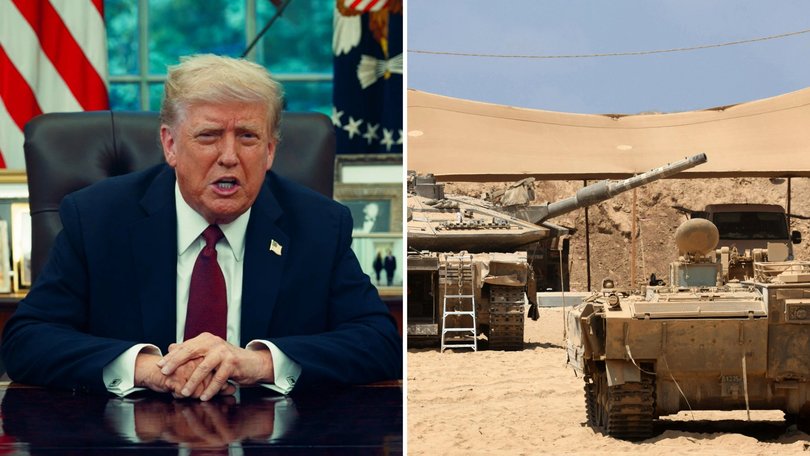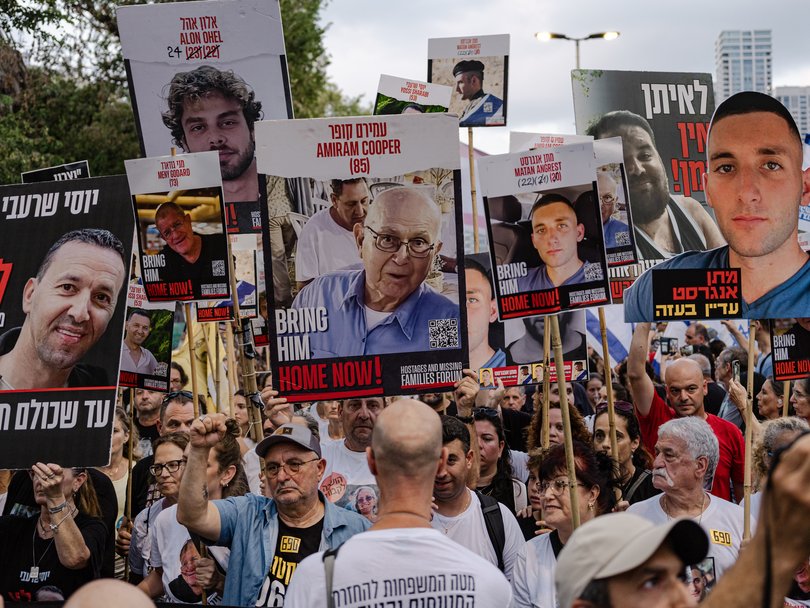THE NEW YORK TIMES: Trump says Hamas is ready for peace and tells Israel to ‘stop bombing’ Gaza

Hamas said on Friday that it was ready to release its remaining Israeli hostages as part of an American-proposed ceasefire plan, a potential breakthrough two years after the group led the attack that set off the war in the Gaza Strip.
But the militant group made clear it wanted to negotiate other elements of the plan proposed by President Donald Trump this week, leaving open the question of whether its offer would satisfy Israel.
Trump said on social media Friday evening that he believed the group was “ready for a lasting PEACE,” and he demanded that Israel “immediately stop the bombing of Gaza.”
Sign up to The Nightly's newsletters.
Get the first look at the digital newspaper, curated daily stories and breaking headlines delivered to your inbox.
By continuing you agree to our Terms and Privacy Policy.The Israeli government did not immediately make a public statement. Prime Minister Benjamin Netanyahu of Israel had already agreed to the American-backed 20-point proposal, but it was not clear late Friday, the Sabbath in Israel, how he would react to Hamas’ response.
The Hamas statement, posted online, was ambiguous in its language and did not address specific issues. The group said it would release the hostages “according to the exchange formula contained in President Trump’s proposal, and as the field conditions for the exchange are met.” Hamas did not specify what it meant by field conditions.
The statement also said the group agreed “to hand over the administration of the Gaza Strip to a Palestinian body of independent technocrats, based on Palestinian national consensus and Arab and Islamic support.”
It was not clear from that language if Hamas had agreed to a stipulation in the proposal that called for the group to be barred from exercising future political power in Gaza or if it saw a place for itself or its members among that body of technocrats.
The statement also did not address key elements of the American proposal that called on the group to disarm, which has been a major demand of Israel’s. And Hamas did not respond to the offer of amnesty for members who commit to coexistence.

The statement did make clear that Hamas wanted to play a role in the discussion of the future of the Palestinian people. Hamas said it wanted there be a debate among Palestinians over issues “relating to the future of the Gaza Strip and the inherent rights of the Palestinian people.” And it said that “Hamas will be a part” of that discussion and “will contribute responsibly” to it.
Hamas’ statement was released hours after Trump used a 300-word post on social media to set a Sunday deadline for leaders of the group to agree to the proposal he had unveiled Monday. If the group didn’t, the president suggested, he would endorse Israel’s continuing offensive in the Gaza Strip, saying “all HELL, like no one has ever seen before, will break out against Hamas.”
The war has already killed more than 64,000 people in Gaza, both combatants and civilians; razed large parts of the territory; and led to a humanitarian crisis of a lack of medical care, as well as malnutrition and, in some parts of the enclave, famine, according to a global group backed by the United Nations.
The ceasefire proposal calls for an immediate end to the war as soon as both sides agree to the accord. Within 72 hours of an agreement, Hamas would free all the remaining hostages seized in its October 7, 2023, attack on Israel, in which roughly 1,200 people were killed and 250 others taken hostage.
In exchange, Israel would release about 250 Palestinian prisoners serving life sentences for militant activity, as well as about 1,700 Palestinians detained during the war in Gaza.
An estimated 20 living Israel captives are believed to remain in Gaza, along with the bodies of about 25 others.
Under the proposal, Israeli forces in Gaza would withdraw to agreed-upon lines, maintaining a buffer zone within the territory. And the international community would begin injecting more desperately needed aid into the Gaza Strip.
The long-term aspects of the proposal are more complicated and could become sticking points before any hostages are released.
Hamas’ rule in Gaza would end and be replaced by a “technocratic, apolitical Palestinian committee,” according to the proposal. That would be overseen by a supervisory “Board of Peace” led by Trump as chair, with a leadership role for Tony Blair, the former British prime minister.
Hamas members who commit to “peaceful coexistence and to decommission their weapons” would be given amnesty, according to the White House. Other Hamas fighters who wish to leave Gaza would be given safe passage into exile.
The United States and its Arab allies would work to develop an international force that would “immediately deploy in Gaza,” according to the plan. It would train a Palestinian police force, which would serve as “the long-term internal security solution” in the enclave.
After Hamas issued its response Friday, Yair Lapid, the leader of Israel’s parliamentary opposition, urged the Israeli government to immediately “announce that it is joining the discussions led by President Trump to close the last details related to the deal.”
He said he was willing to provide Netanyahu whatever political backing was necessary to move ahead with the agreement.
Netanyahu might need that backing because Trump’s announcement put him in a tricky political position. He heads a right-wing coalition, at least some of whose members hope to rule Gaza forever and would likely oppose the developing agreement.
Trump released a celebratory video from the Oval Office later Friday, thanking other countries involved in the peace effort, and spoke about it as if it were a nearly done deal.
“This is a big day,” the president said. “We’ll see how it all turns out. We have to get the final word down in concrete.”
He thanked Arab and Muslim countries — mentioning Qatar, Saudi Arabia, Jordan, Egypt and Turkey, along with “so many others.”
Relatives of hostages reacted with a mix of optimism, wariness and weariness.
Yael Adar, who hopes to recover the body of her son taken from Kibbutz Nir Oz, said she has “very cautious hope.” She said she saw Hamas’ response as “evasive — they say yes, but add a ‘but,’ which effectively sends us back to square one.”
Herut Nimrodi, whose son Tamir Nimrodi, an Israeli soldier, has been held by Hamas, said Friday that it was too soon to celebrate.
“They’ve said in the past that they agree to something that’s unacceptable to Israel,” she said. “But the state of Israel should also understand that this is an opportunity it should not miss.”
This article originally appeared in The New York Times.
© 2025 The New York Times Company
Originally published on The New York Times
